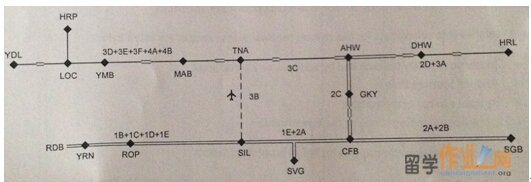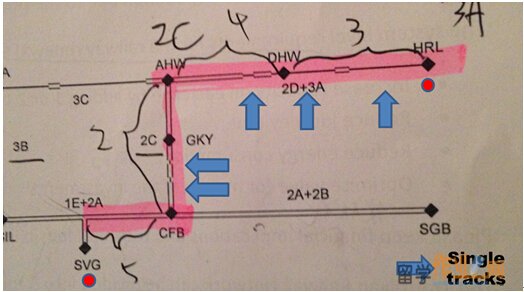|
一般来说,人们普遍认为,基础设施在铁路系统中起着关键作用,因为它是一个决定因素的效率,这个运输系统的有效性和能力(GóóIBáñEZ和德罗斯,2006)。由于高速铁路的出现,铁路系统所载乘客的年量明显增加,对这些系统的容量和效率提出了更高的要求。为了实现铁路系统的整体改善,基础设施的升级有很大的必要性和意义(帕赫尔,2009)。目前,多种可供选择的基础设施升级。在大多数情况下,基础设施升级是整个铁路系统升级计划中最具挑战性的一部分。这是因为基础设施升级的成本非常高,任何微小的结构可能对当地沿线居民的生活产生巨大的影响(从当地社区的升级项目的抗议)(安德森和奥格伦,2007)。因此,选项应该谨慎使用一个有效的方法进行评估。
Generally, it is widely accepted that the infrastructure plays a key role in the railway system as it is a determining factor for the efficiency, effectiveness andoverall capacity of this transport system(Gómez-Ibáñez and de Rus, 2006). Due to the emergence of high speed rails, the annual amount of passengers carried by rail systems has increased significantly, resulting in a much higher requirement on the capacity and efficiency of these systems. In order to achieve an overall improvement of the rail system, infrastructure upgrades are of great necessity and significance(Pachl, 2009).Currently, a variety of options are available for the infrastructure upgrade. In most cases, the infrastructure upgrade is the most challenging part of the whole rail system upgrade program. This is because the cost of infrastructure upgrade is extremely high and any tiny constructions may have a huge impact on the life of local residents along the railway (protest from local communities to the upgrade project)(Andersson and Ögren, 2007). Therefore, options should be evaluated carefully using an effective approach.
1. Evaluation process评估过程
Currently, various approaches for the evaluation of upgrade options and plans have been proposed. Among these approaches, the approach based on the matrix provided byXindi Chen,which is an effective tool to make a brief evaluation of the effectiveness and feasibility of different upgrade options, has gained increasing popularity. With this matrix, high level feasibility assessments can be made for the 28 upgrade options currently available. In this matrix, the evaluations are made based on four key performance indicators, including capacity,customer satisfaction,energy efficiency and feasiblity. The capacity is the core part of the evaluation system as the primary objective of any infrastructure upgrade is to improve the capacity(Van Egmond, 1999). The customer satisfaction is of equal importance as railway transport industry is somewhat a service industry. The energy efficiency is also a key factor as it is a determining factor for the cost. Last but not least, the upgrade option must be feasible in the specific environment of the railway system; hence, feasibility is also important. In the evaluation process with the this matrix, each indicator is either positive or negative (the impact factor), depending on the nature of the specific option; different weighting values (H for high level, M for medium level and L for low level)are given to the indicators based on the characteristics of the specific option.Based on the values of each indicator, an overall score will be given to the specific upgrade optionanda comparison of the scoresis a good reference for the final determination of the best upgrade option.
However, the matrix is not perfectly designed and some improvements are needed for this matrix-based approach (based on results of its actual performances). Firstly, the performance indicators in the current matrix are not able to reflect all key performances of the railway system.For instance, the safety level, to which the highest priority should be given(Farrington-Darby et al., 2005), is not included as a performance indicator in the matrix. This is a severe potential risk as any tiny accident caused by the upgrade program can be a catastrophe which leads to the permanent abolishment of this upgrade option and degradation of the reputation of both the company proposed this upgrade design and the railway operation company adopted it. The second improvement needed is the grading of the weighting value. In the current matrix, the weight value is graded as highvalue, medium value and low value. This design is feasible and useful for quick and brief evaluations. However, this grading system does not exhibit sufficient accuracy to support the final decisions. As a result, this approach cannot be used to facilitate the selection of the upgrade option without complementary methods. Also, the matrix approach is a relatively new method and has not been verified by a sufficient quantity of practical examples.Although the matrix design is convincing in certain ways, a variety of unexpected problems and issues could occur when this system is employed for practical cases. In other words, the credibility of this approach needs to be established with successful industry examples.
2. Evaluation results and discussion重估结果与讨论
The options available for the railway upgrade projects include the rail modernization (such as single track to double track and 2-aspect signalling system to 3-aspect signalling system), construction of new stations in certain areas and renovation of existing stations (to increase the passenger flow allowed)(Profillidis, 2014). In other words, the speed limit on rails (especially the major ones) and the capacity of the railway stations should be significantly improved.The infrastructure of the Transilvan Railway networkis shown in Fig.1. In the case of Transilvan Railway network, several infrastructureupgrade options are available. These options include upgrading of the five sections of single tracks(see Fig.2) to double tracks (together with upgrading of signalling system from 2-aspect to 3-aspect type),renovation ofAHW and CFB stations and construction of a new segment of tracks between HRL and SGB.

Fig.1 The Transilvan Railway network infrastructure

Fig.2 The scope map of the Transilvan Railway network
For the upgrading of tracks, the current capacity of the track section between DHW and HRL is 1.5 trains/hour. After installation of double tracks, the capacity is expected to be improved to 5.5 trains/hour (same as the capacity of SGB-CFB section). For evaluations by the matrix, this option exhibits positive high level impacts on the capacity, positive medium levelimpact on the customer service (faster and smooth journey) and energy efficiency (reduced acceleration and deceleration actions by the trains). Additionally, the cost of this upgrade project is fair. Nevertheless, the feasibility is quite low as this plan leads to the interruption of train services on this line in a certain period (reduced capacity and degraded customer satisfaction).
For the renovations of AHW and CFB stations, the feasibility is significantly higher than the track upgrading option as it does not lead to interruption of train services. In addition, the cost required for this option is relatively low.Nevertheless, the impacts on the capacity and energy efficiency are at positive low levels, although the customer satisfaction may be improved at a medium level.
For the construction of new tracks between HRL and SGB, the impacts on capacity, customer satisfaction and energy efficiency are at positive high level. More importantly, the feasibility of this option is the highest among all options; it does not affect the train services on the existing line. However, the construction of a new track section requires a huge investment, which means the investment/return ratio is not high (compared with the other two options) and the return period may be quite long.
Conclusions总结
A matrix-based evaluation approach for railway infrastructure upgrade is described and used for the selection of upgrade options for the Transilvan railway network. The advantages and drawbacks of the options available are listed and discussed. Based on that, it is concluded that the proposedevaluation approach is a good choice for quick evaluation of railway infrastructure upgrade options.
References文献
ANDERSSON, H. & ÖGREN, M. 2007. Noise charges in railway infrastructure: A pricing schedule based on the marginal cost principle. Transport Policy, 14, 204-213.
FARRINGTON-DARBY, T., PICKUP, L. & WILSON, J. R. 2005. Safety culture in railway maintenance. Safety Science, 43, 39-60.
GÓMEZ-IBÁÑEZ, J. A. & DE RUS, G. 2006. Competition in the railway industry: An international comparative analysis, Edward Elgar Publishing.
PACHL, J. 2009. Railway operation and control, VTD Rail Publishing.
PROFILLIDIS, V. A. 2014. Railway management and engineering, Ashgate Publishing, Ltd.
VAN EGMOND, R.-J. 1999. Railway capacity assessment, an algebraic approach, Delft University Press.
|
 |
|||
| 网站地图 |

